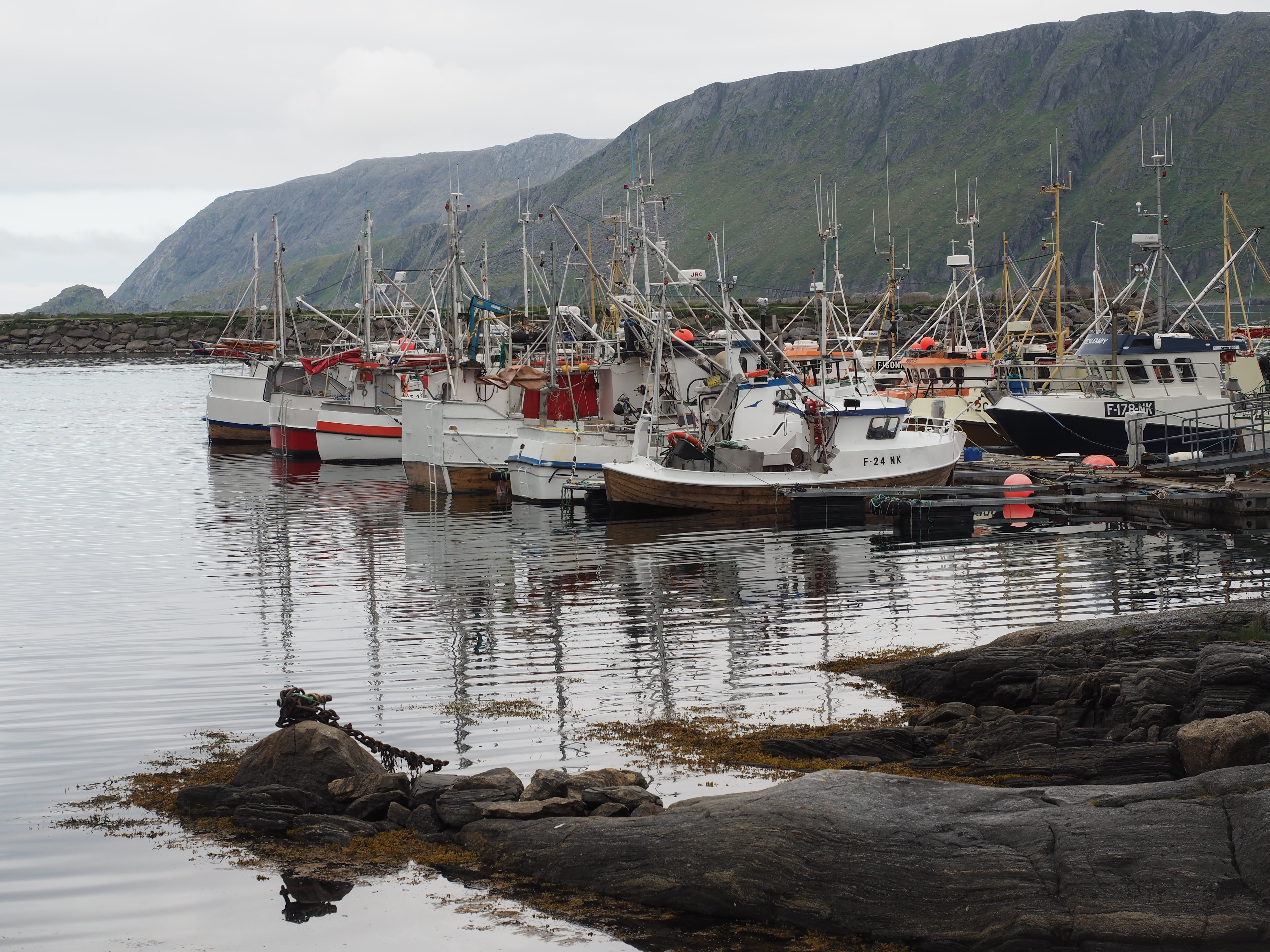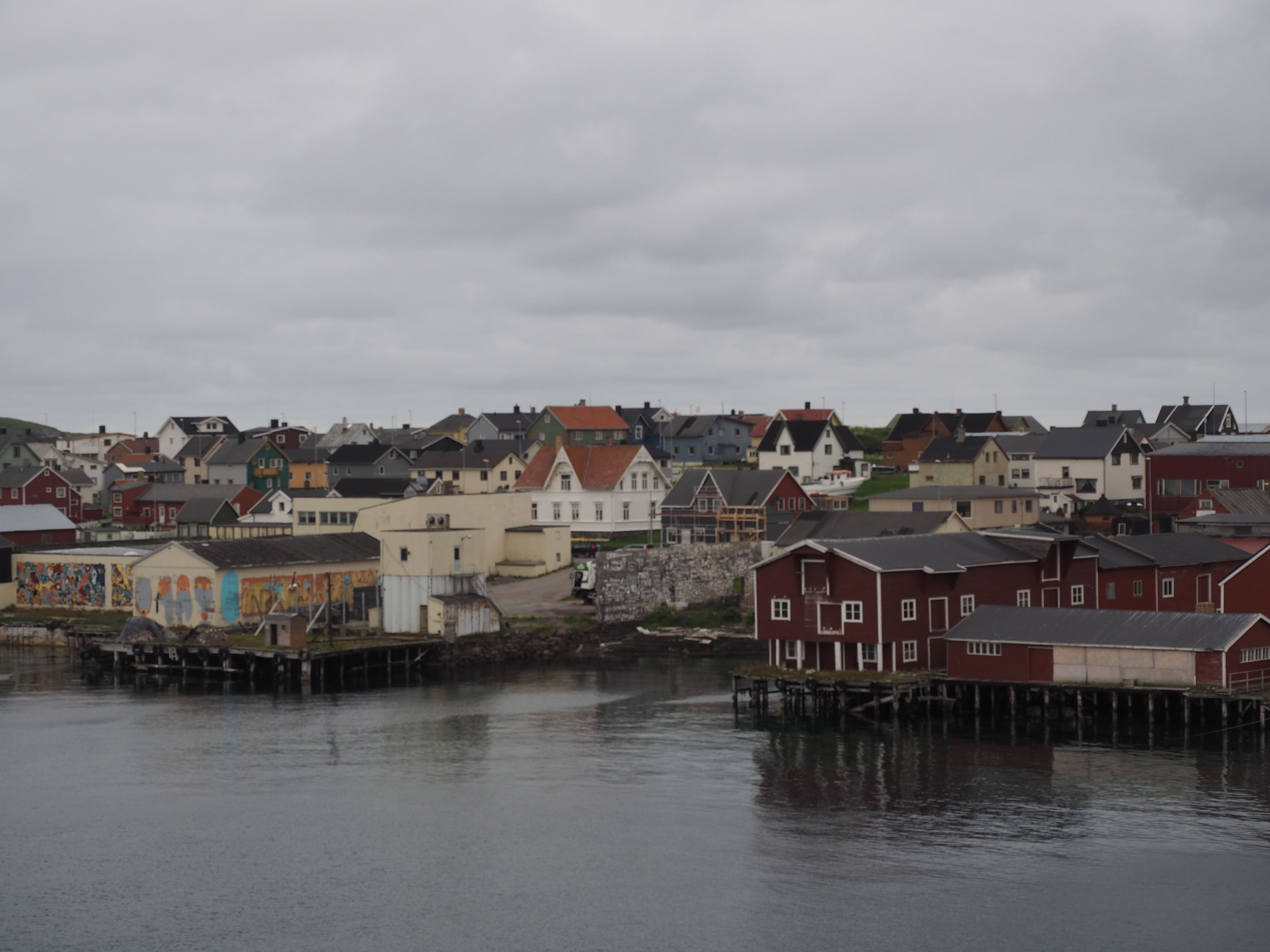Adding a new region to its growing list of destinations, Hurtigruten Expeditions has announced that it will be sailing to Russia, and particularly the White Sea in Russia’s far north. The 17-day "Expedition Cruise to the White Sea–Norway and Russia Adventure" itinerary will begin from Bergen, Norway on October 6, 2022, and sail north along the Norwegian coast.
While in Norway, guests will marvel at the fjords, and head to the Lofoten Islands, settlements rich in fishing traditions and Sami history, and the North Cape, the northernmost point of the European mainland. This will be followed by seven days in Russia, where guests will be traveling to one of the least visited parts of the country.
The itinerary offers a mix of modern-day Russian cities and historic ports with expedition landings, coming ashore at rarely visited and isolated villages along the White Sea. Guests will also have an opportunity to visit the Solovetsky Islands, one of Northern Russia’s iconic sights. As always, Hurtigruten’s on-board expert team will give guests an insight into the history and culture of the places they visit. Among other highlights are visits to Murmansk, where guests can learn about its wartime and maritime past, and Arkhangelsk, the cultural and historical capital of Russia’s north.
Guests will explore Norway and Russia aboard the MS Spitsbergen. With only 180 guests onboard, the ship provides an intimate, exclusive setting during the trip. MS Spitsbergen has expedition equipment, a Science Center and a range of "Citizen Science" research projects that guests can participate in during the voyage. (travelagentcentral.com)
Why travel to Russia with Hurtigruten?
Well, let's start with why travel with Hurtigruten, period:
Hurtigruten Group is the world’s leading adventure travel group, offering unique small-ship and land-based adventures from pole to pole – and anywhere in between. They take their guests to the most spectacular areas on the planet, offering a mix of pristine wilderness and visits to genuine local communities.
Hurtigruten Group is revolutionising the travel industry’s approach to sustainability, allowing them to offer authentic local experiences while leaving a footprint they are proud of — both in nature and with the communities they visit.
Their commitment to safety is as absolute as their passion for exploration. Safeguarding their guests, colleagues, partners, wildlife, nature, and the communities you'll visit will always be their number one priority. Everyone on a Hurtigruten adventure will always be – and feel – safe, comfortable – and excited!
Experience Soviet history, a unique culture, and remote islands on a novel expedition cruise to Russia’s rarely visited White Sea
For decades, few outsiders have been able to visit Russia’s White Sea region, shrouding it in an air of mystery. On this exciting expedition cruise, witness Soviet-era monuments and discover the haunting beauty of this fascinating and pristine region.
- A tale of two cities
Soak up Russian culture and history in two of its northernmost cities. Learn about Murmansk’s wartime and maritime past before taking in the beautifully preserved architecture of Arkhangelsk, the cultural and historical capital of Russia’s north.
- Pearls of the White Sea
Witness the natural beauty of the UNESCO-listed Solovetsky Islands, dubbed the ‘pearls of the White Sea’. We’ll visit peaceful Bolshoy Solovetsky, home to one of Russia’s most famous and iconic monasteries—and former gulag.
Let's take you on this two-part journey. On the one hand you have the awe-inspiring scenery of the Norwegian coast, and on the other the pristine isolation of Russia’s White Sea region.
Scenic Norwegian fjords and colourful fishing towns:
The beautiful Hjørundfjord is our first stop before we sail across the Arctic Circle and visit the picture-perfect Lofoten Islands.
Next it’s on to the idyllic fishing village of Sommarøy before stopping at North Cape, the northernmost point of the European mainland. Vardø, once a home for the Pomor people to trade with Russia, is our last stop before leaving Norway.
Expedition cruise adventure in Russia’s White Sea:
The port of Murmansk is the first in the White Sea region, where routes and landing sites are dependent on weather conditions. The city of Arkhangelsk marks our first stop before we move on to the rarely visited Solovetsky Islands. On our last day in the White Sea, weather permitting, we aim to visit a traditional village on the southern coast of the remote Kola Peninsula before returning to Murmansk.
Our last two days are spent back in Norwegian waters. In Troms og Finnmarken, we aim to make landfall and explore. On our second-to-last day, we drop anchor near the stunning Lyngen Alps. We will spend our last day hiking, kayaking, and enjoying the beauty of the landscape.
We say farewell in Tromsø, the starting point for many Arctic expeditions, many of which are detailed at the Polar Museum. For those looking to extend their journey, we offer an optional Post-Program in Tromsø.
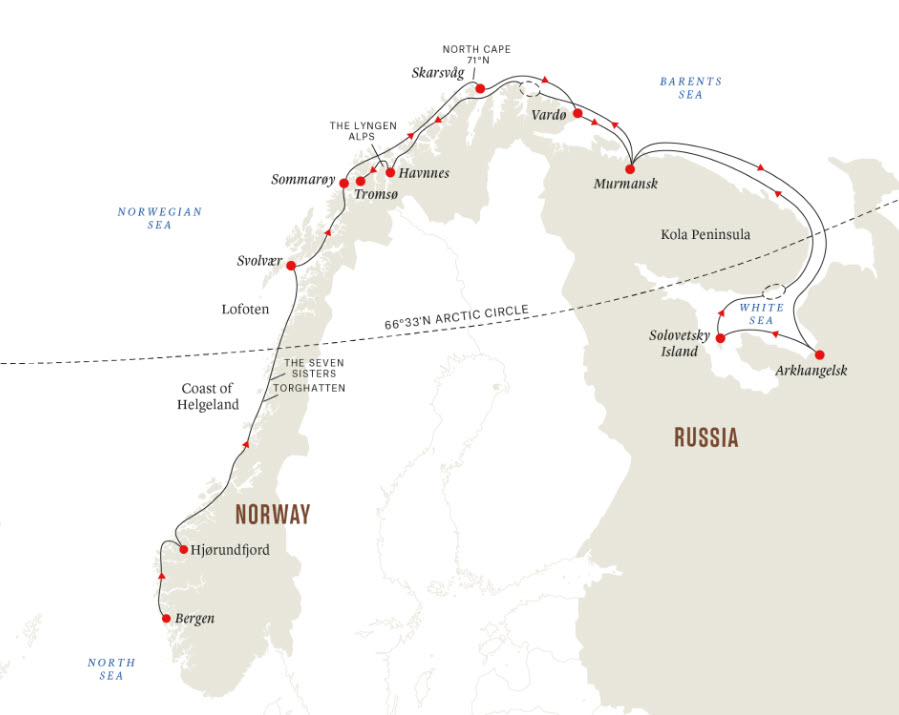
Here is a day-by-day breakdown of your journey of 17 Days on the MS Spitsbergen - departing October 6, 2022
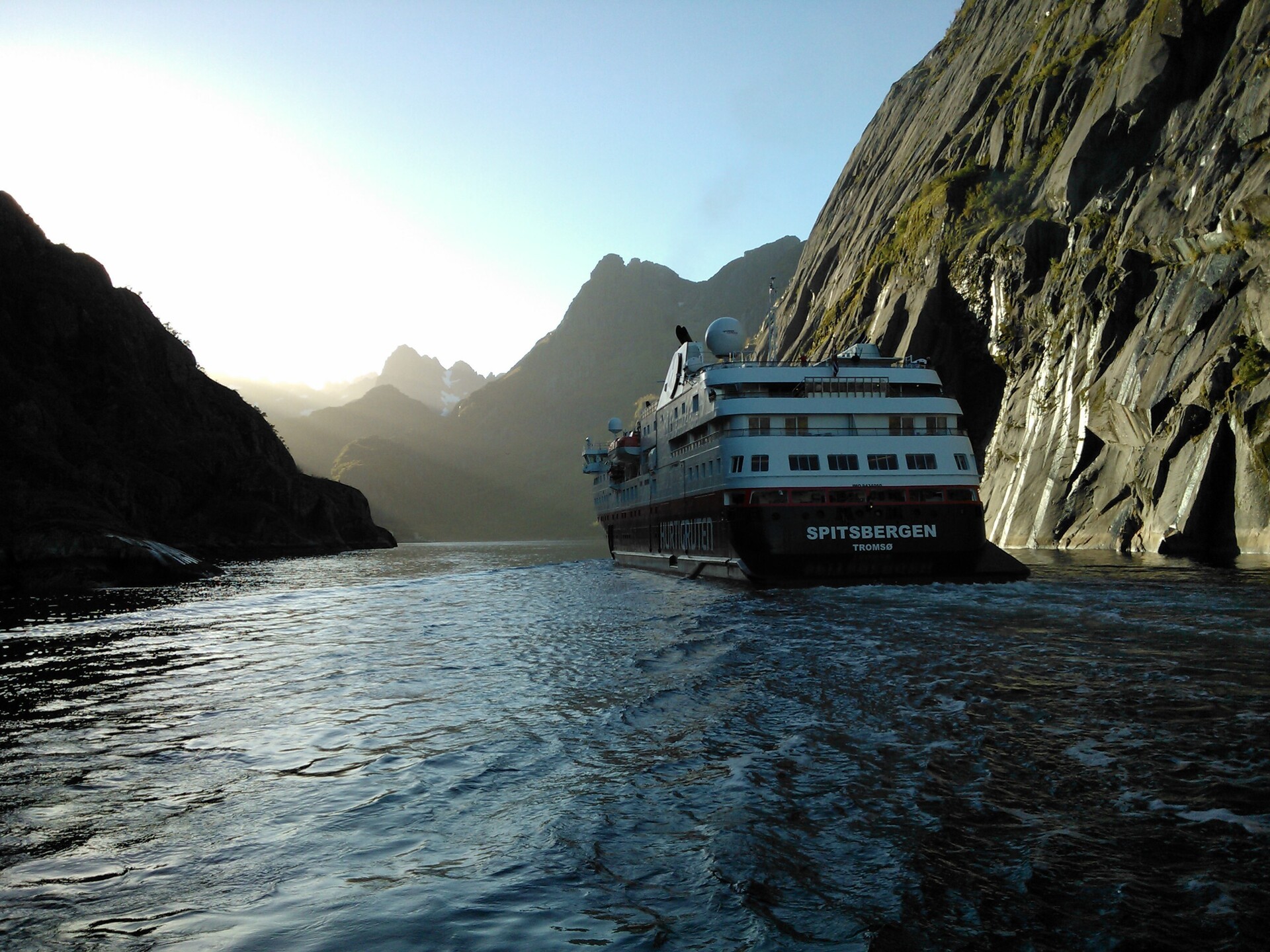
Image by Stephanie Arramon/Hurtigruten
Day 1: Bergen, Norway
Even before we set sail, whip up your zeal for exploration in Bergen, the gateway to the fjords.
Bergen´s historic harbor area is a perfect prelude to your expedition, so head over and explore it before you sail. Pay a visit to famous Bryggen wharf, a UNESCO-protected site full of independent boutiques where you can buy handicrafts made by local artisans.
The funicular railway has transported visitors to the top of nearby Mount Fløyen for over 100 years. Take it and enjoy a bird’s-eye view of Bergen. Looking across this picturesque city, you’ll be drawn to the blend of colorful homes, mountain scenery, and clear blue water. As you scan the port area, you may even spot our ship, MS Spitsbergen, docked and ready to set sail.
Once aboard our small expedition ship, settle into your cabin before attending a mandatory safety drill. Then, we’re off! Locate the Science Center, the Explorer Lounge & Bar, our onboard restaurant, and the observation deck. You’ll surely be frequenting these areas. After the welcome dinner, where the Captain will raise a toast to our expedition cruise, sink into an armchair in the Explorer Lounge with a glass of wine. The time is finally here; your expedition is underway!
Pre-Program
If you can make extra time for Bergen, why not book our Pre-Program and sample more of what this charming city has to offer.
Day 2 - Fjord Landscapes
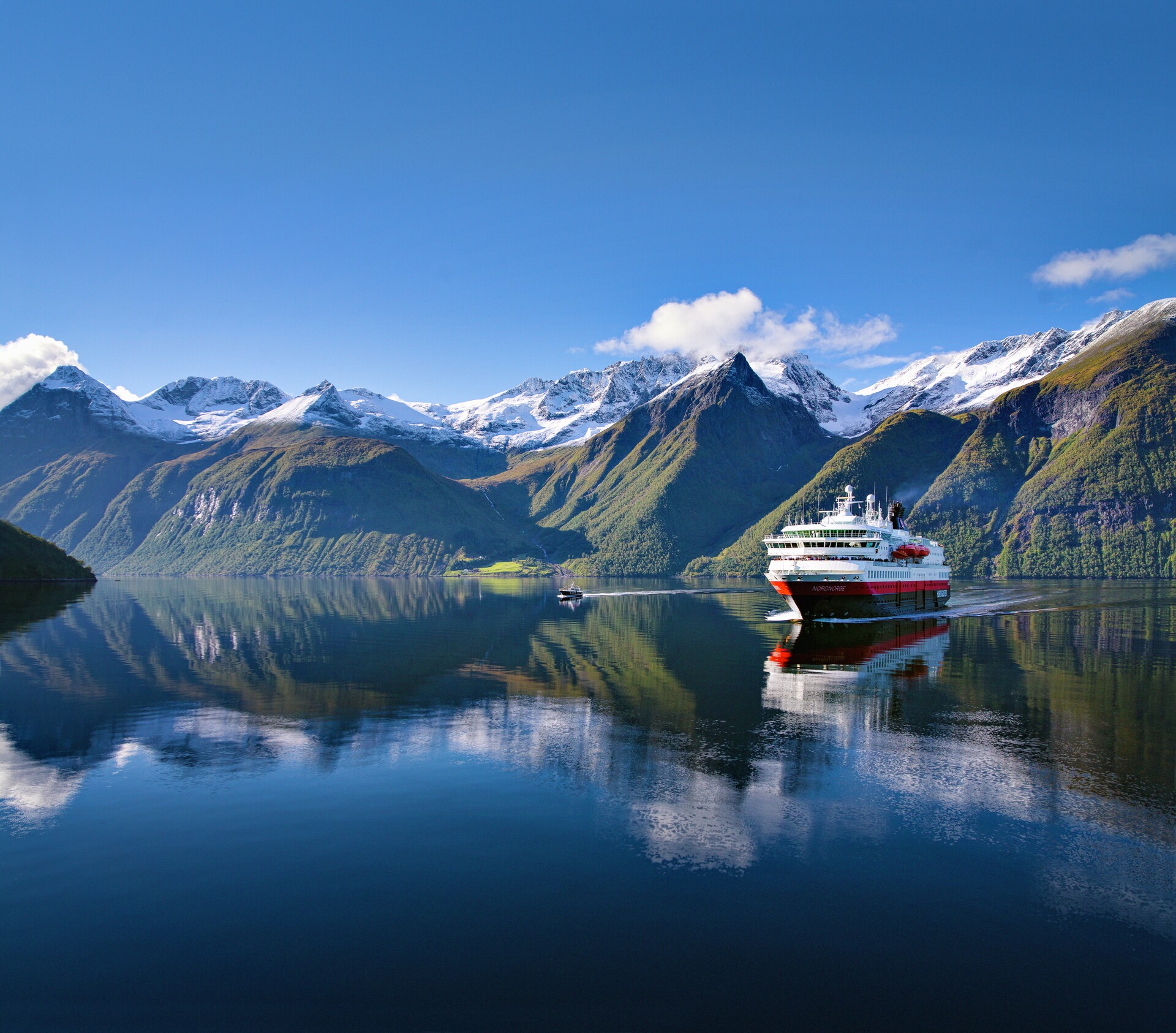
Image by Fabrice Milochau/Hurtigruten: A beautiful day in Hjørundfjord (MS Nordnorge)
Even though Norwegian fjords are world famous for their breathtaking beauty, Hjørundfjord will surprise even the most seasoned traveler. This natural wonder stands out from other popular fjords for its solitary grandeur—this haven is far off the tourist track. Hjørundfjord is considered one of the purest and most beautiful fjords in Norway.
Our foray into the Norwegian fjords gives a rare glimpse of the terrain that early pioneers like William Cecil Slingsby and Roald Amunsden would have encountered as they explored this vast area. The majestic peaks of the Sunnmore Alps provide a dramatic backdrop to the stunning scenery, as they cast their shadows over the still waters of the fjord.
The steep terrain makes cultivating the land here a challenge, but even so, you’ll see a few isolated farms dotted about the shoreline as we sail by. How do the local farmers cope under such challenging conditions? The Expedition Team will inform you about the traditional methods used here for centuries, handed down from generation to generation.
We’ll anchor close to a settlement in the fjord and head ashore. Enjoy the crisp autumn air and scenic landscapes, and even set off on foot to explore the area.
Day 3 - Sailing North
We’ll spend the day at sea sailing north toward the picture-perfect Lofoten Islands. The Expedition Team will prepare you for the adventures ahead with lectures and talks in the Explorer Lounge. These informative and interactive sessions give you insight into our upcoming destinations, including crossing the Arctic Circle, and reveal some of the myths and legends from the areas we sail through.
If you haven’t already, this is a great time to try out MS Spitsbergen’s amenities. Soak in the hot tubs or work up a sweat in the gym or the panoramic sauna. What could be better than sitting in a warm sauna as the majestic autumnal landscapes of mountain and fjord slowly pass by outside?
The next few days could be our first opportunity to see the Northern Lights on our cruise. The Expedition Team will be on hand to offer tips and tricks on how to get the best photos of the mesmerizing colors.
Day 4 - Majestic Beauty of the Lofoten Islands
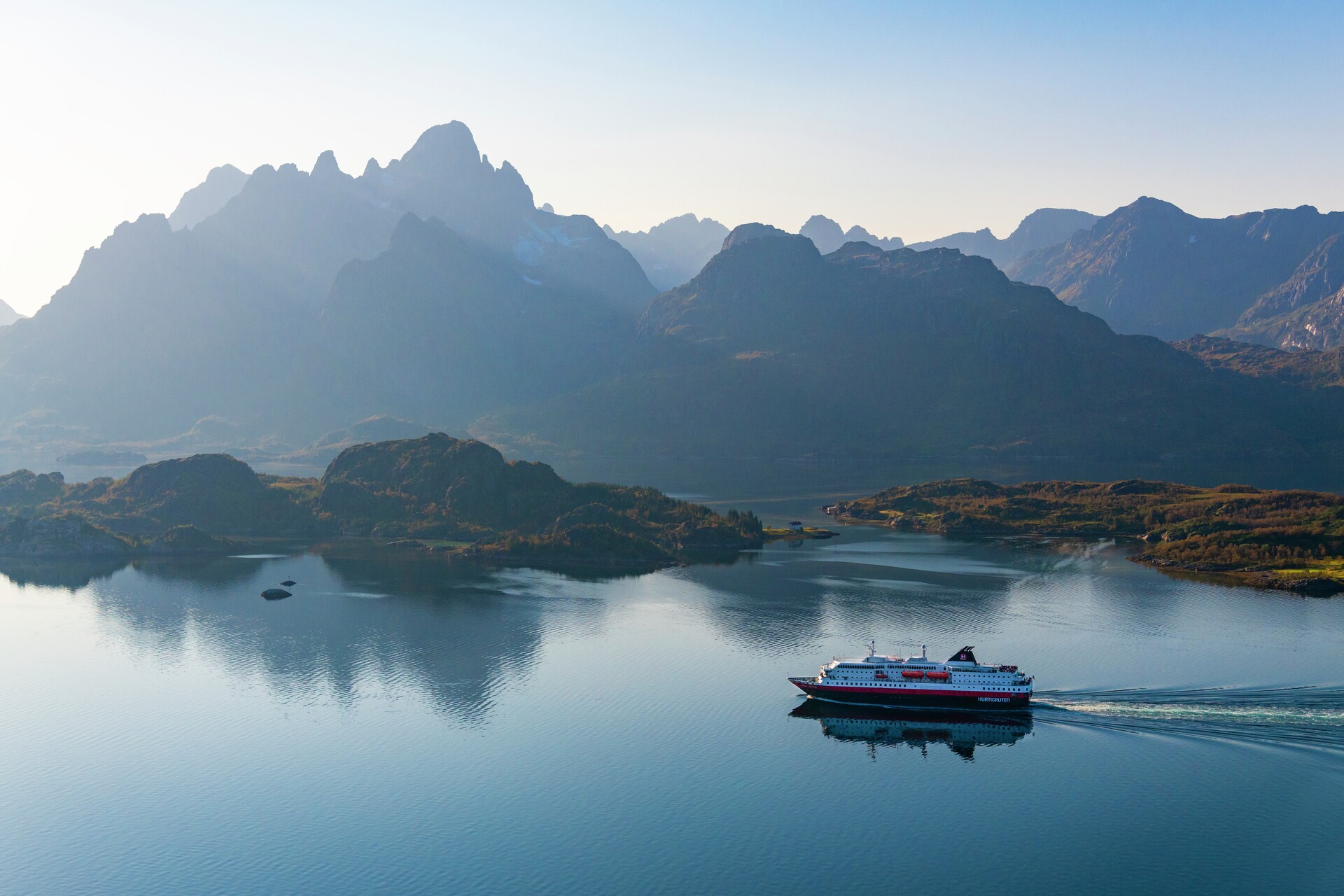
Image by Stian Klo/Hurtigurten - The Main lane for ship traffic between Lofoten and Vesteralen
Welcome to the Lofoten Islands. This picturesque archipelago will take your breath away. This group of untamed islands have cultural roots deeply associated with the Vikings and are a must-see for anyone wanting to experience Norway. These rocky outcrops sit above the Arctic Circle. Our Captain, along with the Expedition Team, will mark our crossing with a time-honored ceremony on deck.
The combination of dramatic peaks, sheltered coves, and pristine waters is simply beautiful beyond compare. Lofoten is also known for its picturesque villages and sandy beaches. As we approach Lofoten, the massive wall of mountains will slowly rise up out of the sea and into view. It’s a sight you’ll never forget.
Harvesting the seas has been a way of life here for centuries. The fishing villages and their photogenic cabins (called rorbu) are sure to delight you, as they are set out in rows along the shore. Originally built to house seasonal cod fisherman, these cabins give the villages a true old-world feel.
Svolvær, the biggest town on the archipelago, is close to Lofoten’s many magnificent sights. It provides easy access to activities like kayaking, hiking, and expedition boating. Pop in to the interesting shops, galleries, cafes, and restaurants dotted around town.
Day 5 - A picture-perfect Island
Farther north, our cruise will bring us to Sommarøy, set in an archipelago of small islands with white, sandy beaches and a lively fishing industry. Sitting just above sea level, the village, with its scattering of small dwellings nestled into the hillside, is a delight to the eye. During summer, these islands experience 68 days of complete sunlight. In winter, they endure 48 days of complete darkness.
Around 400 people live on the islands and visitors are always welcome. Inside the local shop, you’ll find the locals’ Kaillkråa, a corner reserved for simply hanging out, where islanders chit-chat with friends. They even have their own hooks on the wall to hang their mugs. The hooks are reserved for the regulars, but you’re welcome to pull up a chair and spend a few moments hearing about what life is like here.
We offer a variety of excursions in Sommarøy, such as hiking in the hills and kayaking in the clear, blue waters that surround the island. You may also take the opportunity to visit nearby Tromsø, the so-called ‘Gateway to the Arctic’.
You’ll be back to Tromsø later on in your cruise, so a visit here would be a sneak peek into what this colorful Norwegian city has to offer. Set against a dramatic backdrop of mountains, Tromsø is also a great place to browse small shops. As the days become cooler, why not treat yourself to a traditional knitted jumper? You will see them on sale all over the city. Wearing one will prepare you for the colder days ahead, as we venture even farther north.
Day 6 - North Cape - Europe's Northernmost Point
Image by Susan Tuckey/Penguins2PolarBears - Honningsvag Fishing Village
Today, we spend a full day exploring Skarsvåg, a small fishing village on the island of Magerøya. Nestled in Risfjorden, on the north side of the island, Skarsvåg is the ideal place to make landfall and explore the stunning scenery found here. Brightly colored houses built just below the steep mountainsides come into view as we approach the small harbor, in contrast to the deep greens and blues of the hillsides and sea.
We start the day by taking a scenic bus ride from the landing site at Skarsvåg. It will bring brings us past small bays and tiny villages, then crosses a mountain plateau before arriving at the spectacular North Cape. At 71°10’21´N, North Cape, known in Norwegian as Nordkapp, is just 1,304 miles away from the Geographic North Pole. Standing at the edge of the cliff, gaze out onto the Barents Sea with only the Svalbard archipelago separating you from the North Pole.
Visiting North Cape means having visited the northernmost point in Europe. Snap a must-have photo beside the famous metal globe sculpture and leave yourself time to visit the cinema here, which shows a short film about the North Cape Plateau and features exhibits showcasing the island’s history.
Our Expedition Team will lead an optional walk to Kirkeporten view point, a naturally formed arch that sits on the mountaintop. Looking back at North Cape, you’ll have the perfect angle to photograph the so-called hornet, an unusual rock formation that juts out of the cape and looks remarkably like an animal’s horn. This is also an ideal place for a moment of quiet reflection as you look out on the beautiful scenery.
Day 7 - Pomor Traders and Witchcraft Trials
Image by Susan Tuckey/Penguins2PolarBears
We have one more stop before entering Russian waters. Today we explore Vardø, which is the easternmost settlement in Norway. Along with Hammerfest, Vardø received its charter in 1789, giving these two towns the distinction of being the oldest in northern Norway.
After 1850, the town saw a marked expansion. As fisheries grew in importance, so did trade with Russia's White Sea region. Due to its close proximity to Russia, the city is often referred to as Norway’s ‘Pomor capital’, as it was an important center for trade between the Pomor people of northwest Russia and the people of northern Norway.
Pomor hunters and fishermen were likely already active in Arctic waters during the 16th century, as they built settlements on the various islands. You’ll learn more about these hardy people and the economic and cultural connection between northern Norway and northern Russia at the Pomor Museum.
Vardø has a rich and also somewhat dark history. In the 17th century, it was the center of a number of witchcraft trials in which more than 90 people, Norwegian and Sámi, were sentenced to death. The Vardøhus Fortress took center stage during the trials, and the alleged witches were kept here to await their fate. These days, it houses a museum where you’ll learn all about the its fascinating history.
Join the Expedition Team on a nature walk in the area or visit the Vardøhus Fortress and the witch monument. Next stop: Russia!
Day 8 - Into Russia
Welcome to Russia! Murmansk, founded in 1916, is the largest city north of the Arctic Circle. The origins of Murmansk lie in the Soviet Union’s need for a northern sea port. The maritime influence is still visible.
Once we are cleared into Russia, we will explore some of the city sights and learn more about life in this northern seaport. See monuments celebrating the city’s history—many of them commemorating its military importance during the Second World War—as well as its maritime heritage.
Overlooking the port, you will find a 115 ft statue of a Russian soldier, known as Alyosha. This memorial was erected in 1974 to pay homage to the soldiers who fought in the Second World War. He stands resolute, as if defending the city from invaders to the west. The imposing figure is the second-tallest statue in Russia. Learn more about the lives lost in the war by studying the inscriptions on its pedestal.
Murmansk is home to the world’s first nuclear icebreaker ship, named Lenin. Commissioned in 1959, it spent four decades clearing ice for the cargo ships that traversed the Arctic coast. This nuclear pioneer has been turned into an interactive museum dedicated to the history of the icebreaker fleet.
Our expedition into Russia’s frozen north has just begun. From here, we head further into the cold waters of the Arctic. The ever-changing conditions make each cruise unique and our experienced Expedition Team use this to our advantage. They adapt to the challenges that sailing here can pose and identify opportunities for unique experiences.
Day 9 - Journey to the White Sea
Continuing our journey further east, we’ll sail along the trade routes taken by the Pomor, with Arkhangelsk as our next port of call. Our Expedition Team and their Russian colleagues will prepare you for our destinations ahead with a series of briefings. Lectures might touch on life in the far north of Russia, the history of trade in the region, and the cultures of the Sámi and Pomor people.
We follow the coastline through the Barents Sea until we reach the inlet that flows into the White Sea. This area is almost completely land-locked—for decades, it was forbidden to sail here. Despite being rich in history and natural beauty, its remote geographic location means that it remains an area of mystery to many. Our next port of call will be Arkhangelsk, northwest Russia's cultural capital.
Day 10 - Northern Russia's Cultural Capital
The first place we visit in the White Sea is the city of Arkhangelsk, considered to be the cultural and historical capital of Northern Russia.
Arkhangelsk was founded in 1584 and became an important seaport, as well as a trading and shipbuilding center. The city was the main port of medieval and early modern Russia until it was replaced by St. Petersburg. Considered to be Russia’s ‘Pomor capital’, it was from here that these White Sea people brought grain products and timber to northern Norway in return for fish. Arkhangelsk has also been the launching point to the Arctic for several notable expeditions and played a crucial role as a supply point during both world wars.
The city remains a major seaport and center for the fishing and timber industries. In fact, timber is so widely available that wood is still heavily used in buildings around the city. To learn more about the region’s traditional wooden architecture, visit the open-air museum of Malye Korely. Beautifully preserved architecture, mansions, chapels, and churches showcase the talents of the skilled artisans inspired by local scenery throughout the ages.
As you stroll along the banks of the Northern Dvina, try the local gingerbread, called kozoola, originally a Pomor Christmas specialty. It’s a can’t-miss treat! You’ll also see the many historical monuments to Soviet-era history, going back to Peter the Great. At the Lore Museum you’ll learn more about the region’s remarkable history. The museum is located in the Merchant Yard, Gostny Dvor, the oldest building in Arkhangelsk.
Day 11 - The Pearls of the White Sea
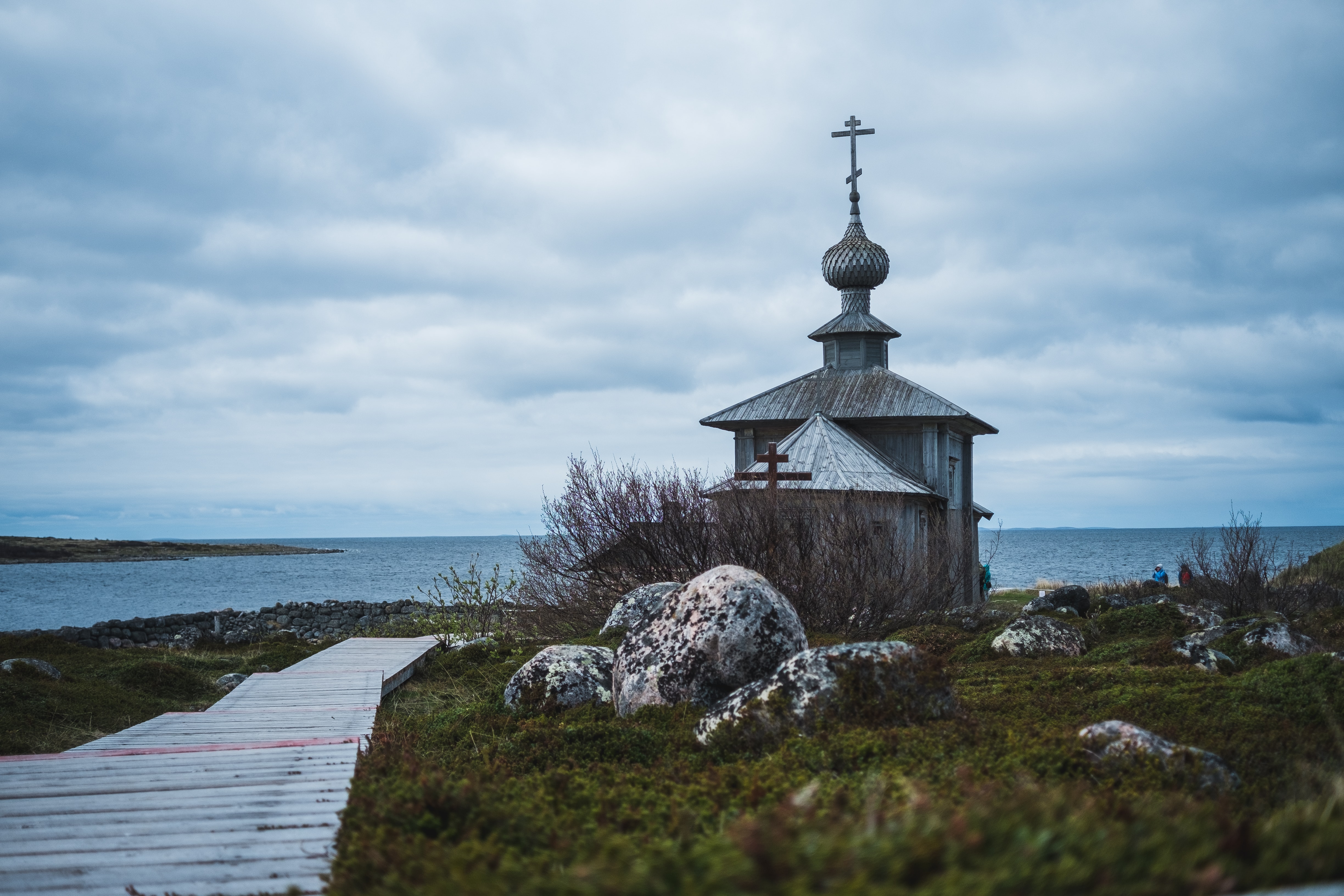
Photo by Radik Sitdikov on Unsplash
Located just below the Arctic Circle in the western part of the White Sea, we find the Solovetsky Islands (sometimes called ‘Solovki’). This rarely visited archipelago consists of six islands and numerous skerries.
The Solovetsky Islands are sometimes called the ‘pearls of the White Sea’. When you see their natural beauty, it’s not difficult to understand why they hold this name. We’ll visit Bolshoy Solovetsky, the largest of the islands, home to one of the most famous and powerful monasteries in Russia, which is now a historical and architectural museum.
During the 15th century, the monastery extended its commercial activities and grew to become an economic and political center of the White Sea. Around this time, it became an enormous fortified citadel with high defense towers around it.
During a particularly dark period in history, this monastery was turned into one of Stalin’s prison camps. In his book The Gulag Archipelago, Russian writer Aleksandr Solzhenitsyn described Solovki as so remote that ‘a scream from here would never be heard’. By exploring the area, you’ll get a feel for what it must have been like for the unfortunate souls exiled here.
The monastery, along with the Solovetsky islands, are protected as a UNESCO World Heritage Sites. A museum here tells the story of Solovki’s history and will give you an insight into the region’s strategic importance.
Day 12 - Exploring the Kola Peninsula
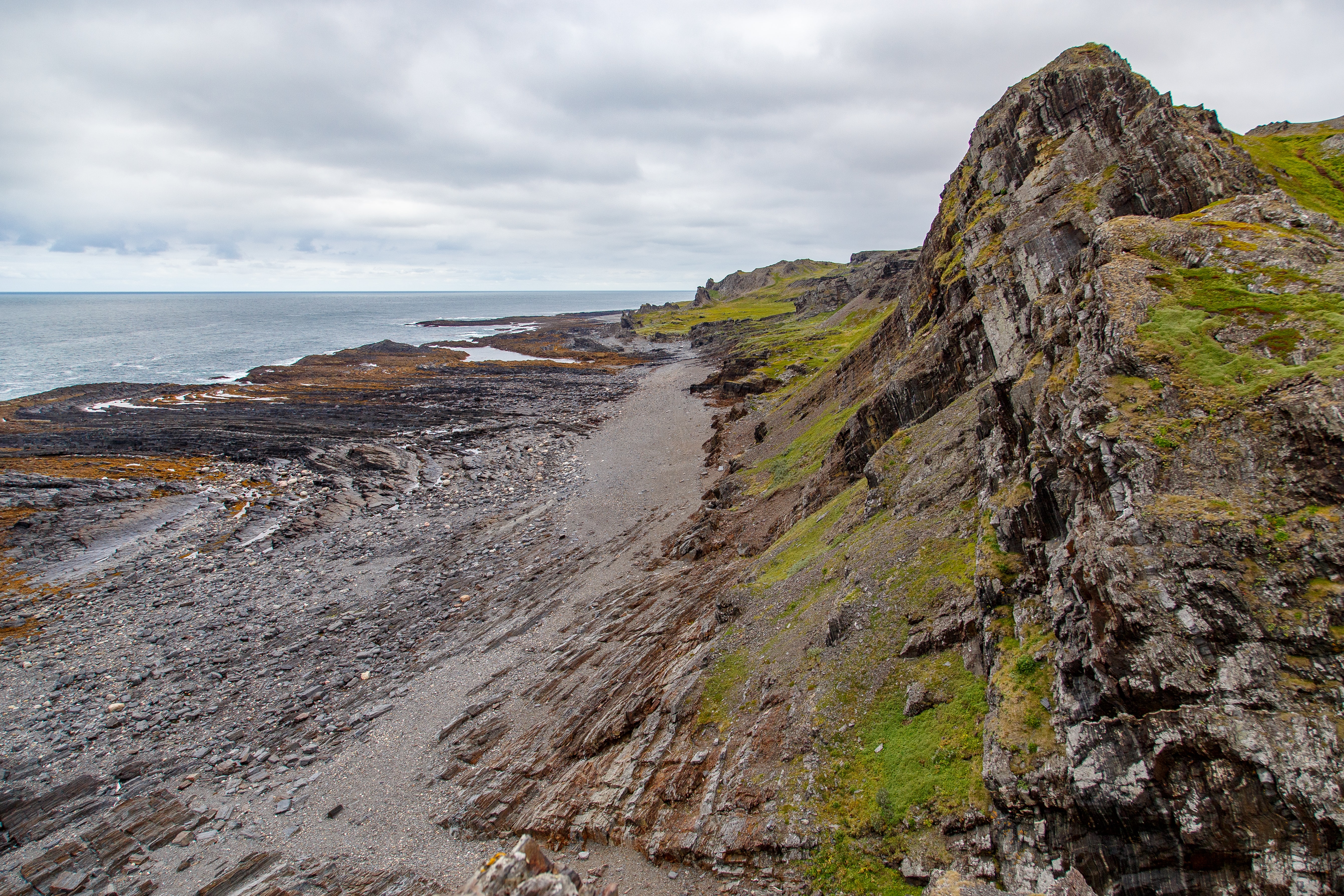
Photo by Alexey Elfimov on Unsplash
As we head back out of the White Sea towards the Barents Sea, we will play a chess game with the season’s changeable weather. Depending on tides and weather conditions, we aim to spend a day exploring the remote Kola Peninsula. We may come ashore on the southern side. If so, you’ll get to visit a local fishing village and enjoy an exploratory nature walk.
The Kola Peninsula sits between the White Sea and the Barents Sea. This vast area has many natural harbors and the whole region is sparsely populated, home to only a few scattered settlements. Your Expedition Team may take you to the small villages of Chapoma or Pyalitsa.
Discover traditional settlement with houses made from wood and other natural materials. People still live traditional lives here, relying on the same fishing and hunting methods used by the original settlers. If conditions and you can set foot in this beautiful area, you’ll appreciate the daily challenges of those who call this harsh area home.
This wild, remote peninsula has much to offer us as we explore. Bring your camera and capture the delicate beauty of the landscapes and delightful views over the White Sea.
Day 13 - Sailing to Murmansk
After an enjoyable few days exploring the secrets of the White Sea, today you have an opportunity to rest and watch the world go by as we sail westward toward the Norwegian border.
The Expedition Team will summarize the journey so far, answer your questions about the, region and prepare you for the coming days’ landings. This could be the perfect chance to simply relax and use the onboard facilities.
Day 14 - A Second Look at Murmansk
Our return journey brings us back to Murmansk. This city has much to offer—more than can be discovered in just a day. You’ll have some more time to explore and learn about life in the largest city north of the Arctic Circle.
Pay a visit to the Church of the Savior on the Waters, built in 2002. This gold-domed church with striking sky-blue steeples overlooks the harbor area. Public donations funded this construction project. It belongs to a complex dedicated to the memory of the Murmansk seamen who perished in peacetime. Take time to explore this unique memorial.
The Lighthouse Memorial also forms part of the same complex, and serves as a reminder of all those who have been lost at sea, both military and civilian. A book listing those who have lost their lives at sea can be found here, as well as a memorial plate with the names of submariners lost during peacetime.
Not everything is gloomy remembrance, though. Murmansk is a modern Russian city and there are numerous bars, restaurants, and cafes for you to explore. Mingling with the locals here will give you a real feel for what life is like in Russia’s northernmost city. As it’s your last day in Russia, now’s the time to buy a souvenir or two.
In the evening, after border clearance is completed, the Captain will set our course for Norwegian waters.
Day 15 - Exploring the Barents Sea
Our voyage to one of Europe’s most remote corners will allow us to see this rugged coastline up close. We’ll explore the area of Troms og Finnmarken and find a suitable fjord, island, or bay to drop anchor. So far, your expedition cruise has led you to experience different conditions. Here, we have another chance to do just that.
The windswept landscape facing the Barents Sea lies in stark contrast to the sheltered fjords cutting deep into the land. The landscape varies greatly between the coastal areas facing the sea, which are barren, and the more sheltered fjord areas and river valleys, which harbor gullies and trees. About half of the terrain is above the tree line, and large parts of the other half are covered with small downy birch.
There are many fjords and possible landing sites to choose from in the area and we will work to find the most suitable.
The ship will anchor off one of the islands or shelter in a small bay, and small boats (RIBs) will bring us ashore to explore the terrain.
Remember, the coastline can be uncooperative throughout the year. If the weather prevents us from landing at one spot, we’ll find an alternative, or even a port. Our Expedition Team will use their knowledge and experience of this area and adapt to these changing conditions.
Day 16 - The awe-inspiring Lyngen Alps
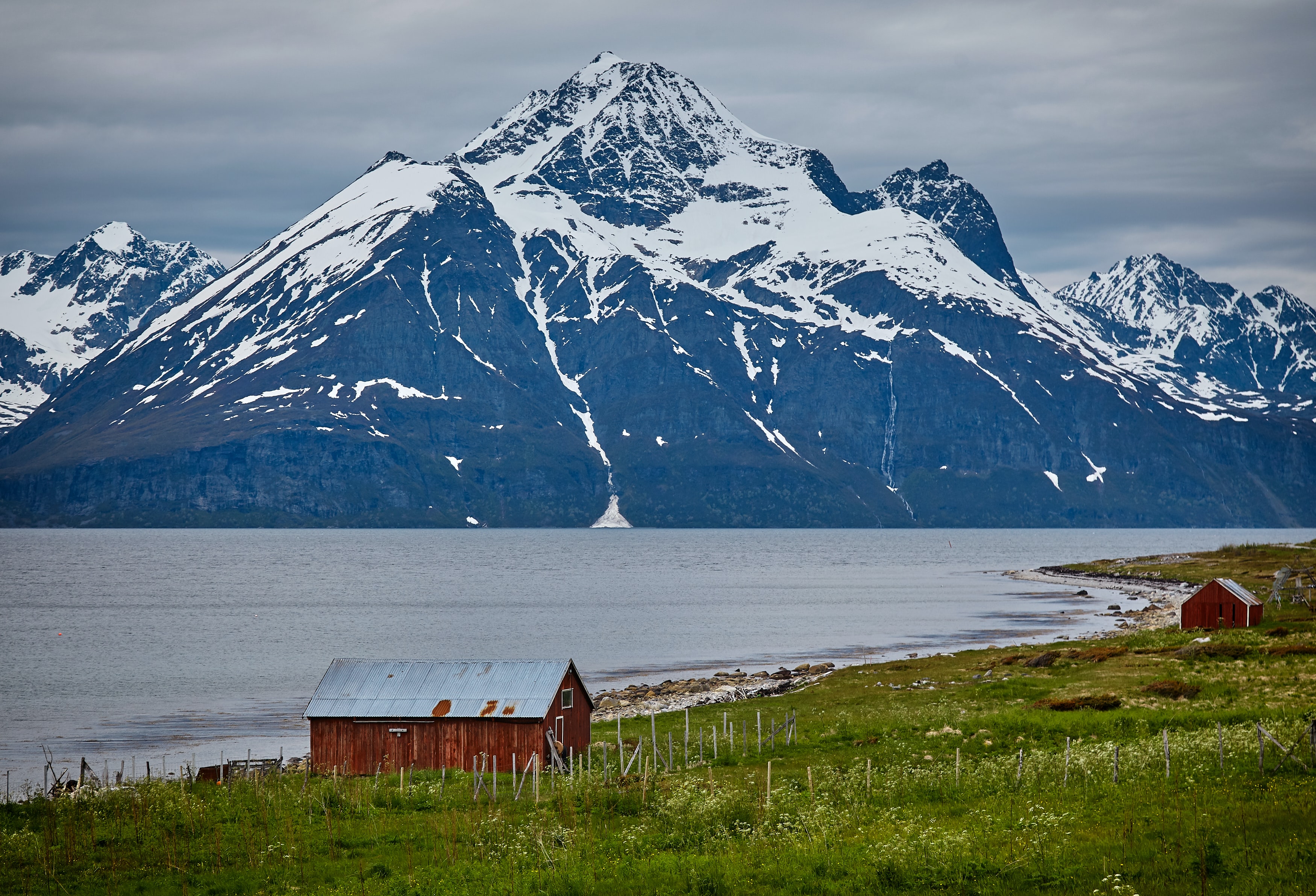
Photo by Vidar Nordli-Mathisen on Unsplash
This morning we’ll sail into a fjord at the base of the magnificent Lyngen Alps. Havnnes is our first stop. This charming seaside town has only a few dozen inhabitants. The battered white houses at this trading post peek just above the waterline, while triangular peaks of the mountains loom above.
Havnnes will send you back in time a century or more to the days of steam and sailing. The locals still use traditional drying methods to cure stockfish, which Norway has exported for centuries. This job was once done by the fishermen themselves, but the locals took it over when the fishermen stopped doing it. This method of drying and preserving fish has been passed down from generation to generation.
Strike up a chat with the friendly residents here and pay a visit to the vintage general store. You can also explore the local museum, an old wooden building on the pier. It features a photo exhibition about the life of Annie Giæver, who took photographs of the area during the first half of the 20th century. The Giæver family have had a huge influence on the settlement throughout the years, and generations of them have managed this trading post since 1795.
If weather conditions are kind to us, walking or kayaking are great ways to enjoy the spectacular surroundings of Havnnes. This penultimate stop on our journey is sure to delight.
Day 17 - End of the Expedition Cruise
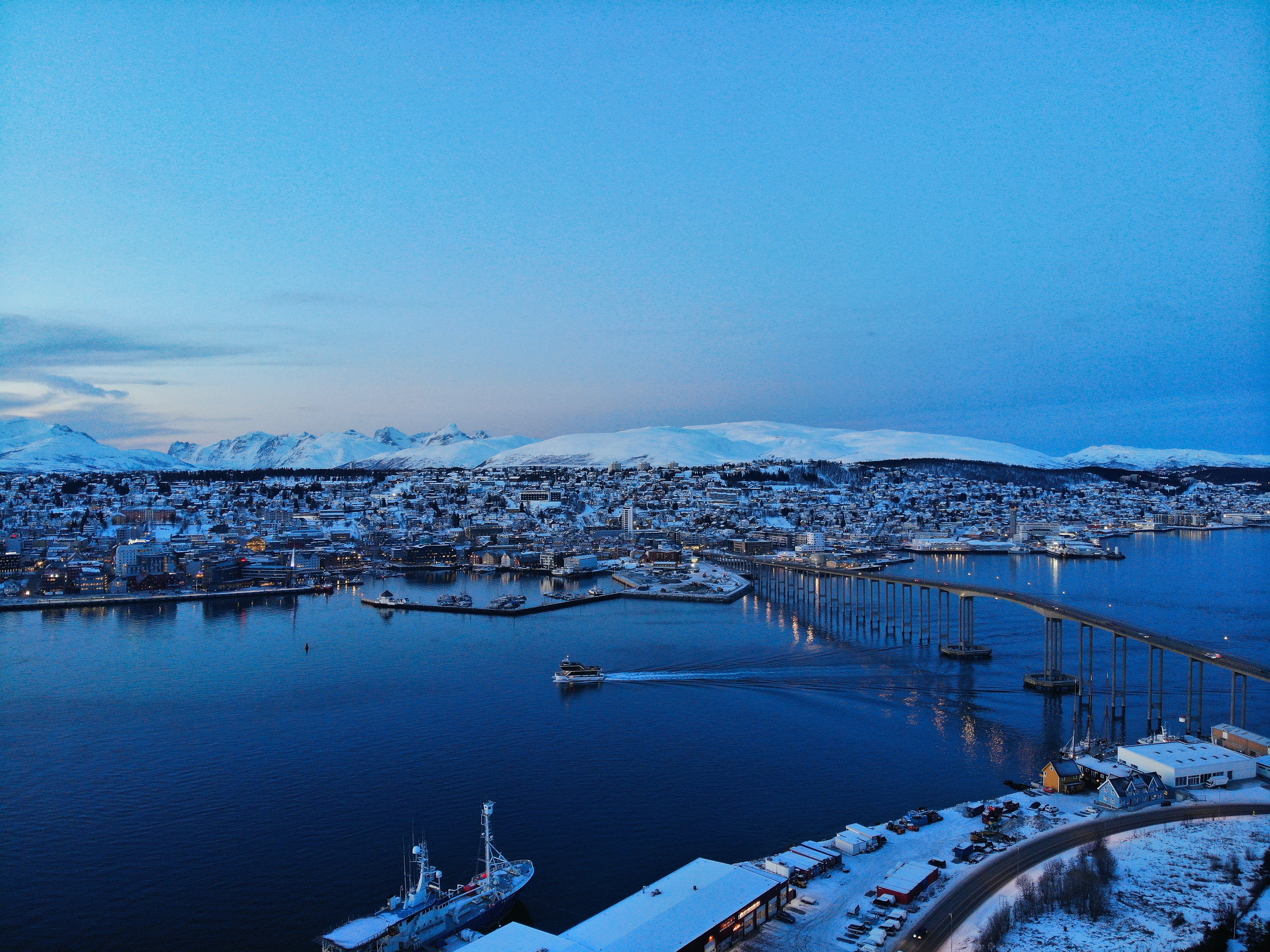
Photo by Dimitris Kiriakakis on Unsplash
As your expedition cruise comes to an end, you’ll find Tromsø a fitting place to conclude the journey. Time flew by, didn’t it? That’s what happens when you travel where few others have gone.
Tromsø is a small city with many great attractions, but it’s also easy to escape into the surrounding countryside, if you feel like it. One way is to take the Fjellheisen Cable Car to the Storsteinen mountain ledge, where you’ll enjoy breathtaking views of the city, mountains, and fjords. Built in 1961, it bears the logo of a polar bear and a seal from the local shipping company that built it.
If you are still on the hunt for the Northern Lights, this may be your last chance to snap a photo of the magical Aurora Borealis. Maybe you just want to sit down and relax after the excitement of the last two weeks. Tromsø offers you many venues to sit and contemplate your experiences with new friends.
The oldest pub in Tromsø, Ølhallen, is the perfect place to enjoy a post-cruise round of drinks. Sample some beers brewed at Mack, the northernmost brewery in the world. What a fitting conclusion to your Norway and White Sea adventure!
Post-Program:
If you feel like extending your journey, we recommend booking our optional Post-Program. This includes a great excursion in Tromsø and a cable car ride to the top of the city. One night in a centrally located hotel is also included in the package.
If you'd like to learn more about this journey, let's schedule a consultation so that I can learn more about you and your interests.
Or sign up for my weekly newsletter:


